Judi Lynn
Judi Lynn's JournalBetter late than never to discover this:
History of Cartagena, Colombia: Spanish America’s Biggest Slave Port
By Tracy -July 4, 2015236335
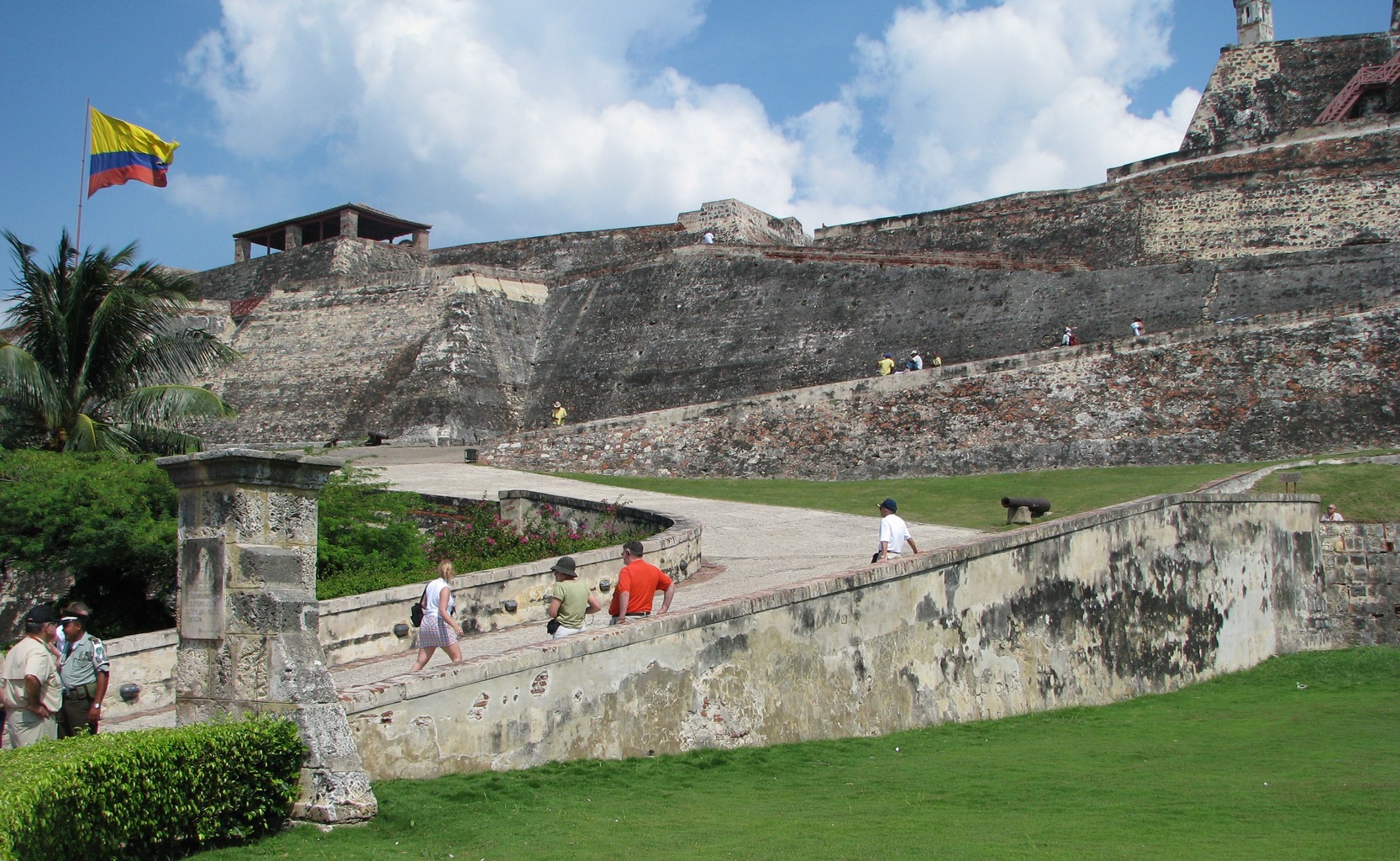
Far too many people are unaware that the Spanish Americas received countless millions of chained African men, women and children during the Maafa. Too often when we think of African slavery in the Americas we are hoodwinked into channeling our focus toward the British North American colonies, Portuguese Brazil the British West Indies or the sovereign Black man’s pearl of Haiti.
There is another place though. One you probably have not studied about. As a matter of fact in the Western hemisphere there does not exist a port of call in all of Spanish South America, Central America or the Spanish Caribbean that saw more Africans delivered than this vicious port: it is the efficiently evil slaving depot of Cartagena, Colombia.
Over 1.1 million captive Africans entered the docks at Cartagena de las Indias, according to the former director of the Colombian national archives, Jose Palacios Preciado. Not only did they come earlier to Cartagena, but they came in considerably larger numbers than Black people to other locales of the Americas such as the Dutch, British, Danish or French possessions. The Spanish Crown had the system of trafficking African souls down to a grizzly science, and made it their MOST PROFITABLE business according to the governor of Cartagena Province during the 16th century. In his words, he confirms, “the business of Blacks is the largest and the most profitable business we have,” and it would continue to be so along with its auxiliary economic effects for the next two and a half centuries until this vile institution’s end in Colombia on Jan. 1, 1852.
Equally as sinister in the early period of slavery were the perilous sister ports of Veracruz, Mexico, and Portobelo, Panama. These two scurrilous locales’ steadily active wharves of disembarkation preceded Cartagena in the heinous business of landing newly arrived captive Africans – bozales as they were called, meaning “wild” or “savage.” They were only overtaken by their southern sibling Cartagena in the late 1590s, when the Spanish Crown stepped up their volume of shipping and initiated the asiento contract period of trafficking African people. The asiento contract, promulgated by the Spanish Crown, was a virtual monopoly to supply Africans to the Spanish Americas. By the mid-17th century according to some scholars, more than 300,000 unfortunate ancestors had already been landed on the shores.
Which Africans Were Brought to Cartagena and the Spanish-American Territories?
That depends on which century, which European nation owned the asiento shipping contract at the time, which region of the Americas you are talking about – be it a sugarcane-producing area (cañaveral), a precious metal-mining area (placer or mina), a cattle-ranching area (estancia), a pearl-diving region, an urban or domestic locale, some other destination, or, as recent evidence has uncovered, in many cases the decision as to which Africans were brought may have relied upon which preferences were held by the local proprietors for certain African-based technologies. As such, the case for the latter aided in the detailed use of brand-naming each African captive sent to or through the port of Cartagena – this system of categorizing African people per their expertise and continental region of origin, is known as the casta de nación classification system.
More:
https://atlantablackstar.com/2015/07/04/cartagena-colombia-spanish-americas-biggest-slave-port/
Colombia's opposition filing criminal charges against 9 generals and Duque ally over illegal spying
by Adriaan Alsema May 15, 2020
Colombia’s opposition announced criminal charges against nine army generals and an ideologue of President Ivan Duque‘s far-right political party, which again found itself accused of having ties to the mafia.
During a debate, Opposition Senator Ivan Cepeda claimed that former National Army commander Nicacio Martinez frustrated a counterintelligence operation that sought to identify mafia associates within the military. Instead, these resources were used to spy on civilians investigating this.
Defense Minister Carlos Holmes Trujillo said last week that 13 military officials would be prosecuted for the alleged spying on journalists, opposition politicians and NGOs as a result of counterintelligence “Operation Stick.”
. . .
The defense minister, a close ally of Duque’s political patron, former President Alvaro Uribe, reportedly tried to block a Supreme Court investigation that brought the intelligence operation to light and is now allegedly trying to conceal the alleged ties between the ruling party, the criminal organization within the military and the mafia.
. . .
Uribe is additionally investigated by the Supreme Court for allegedly trying to manipulate witnesses who have testified that he and his brother Santiago, who are also former cartel associates, founded paramilitary groups in the 1990s.
More:
https://colombiareports.com/colombias-opposition-filing-criminal-charges-against-9-generals-and-duque-ally-over-illegal-spying/
Scotland: 'Mind-blowing' ancient settlement found on hilltop
Archaeologists say up to 4,000 people may have lived in huts near the village of Rhynie in the fifth to sixth century.
By Andy Hayes, news reporter
Thursday 14 May 2020 20:28, UK
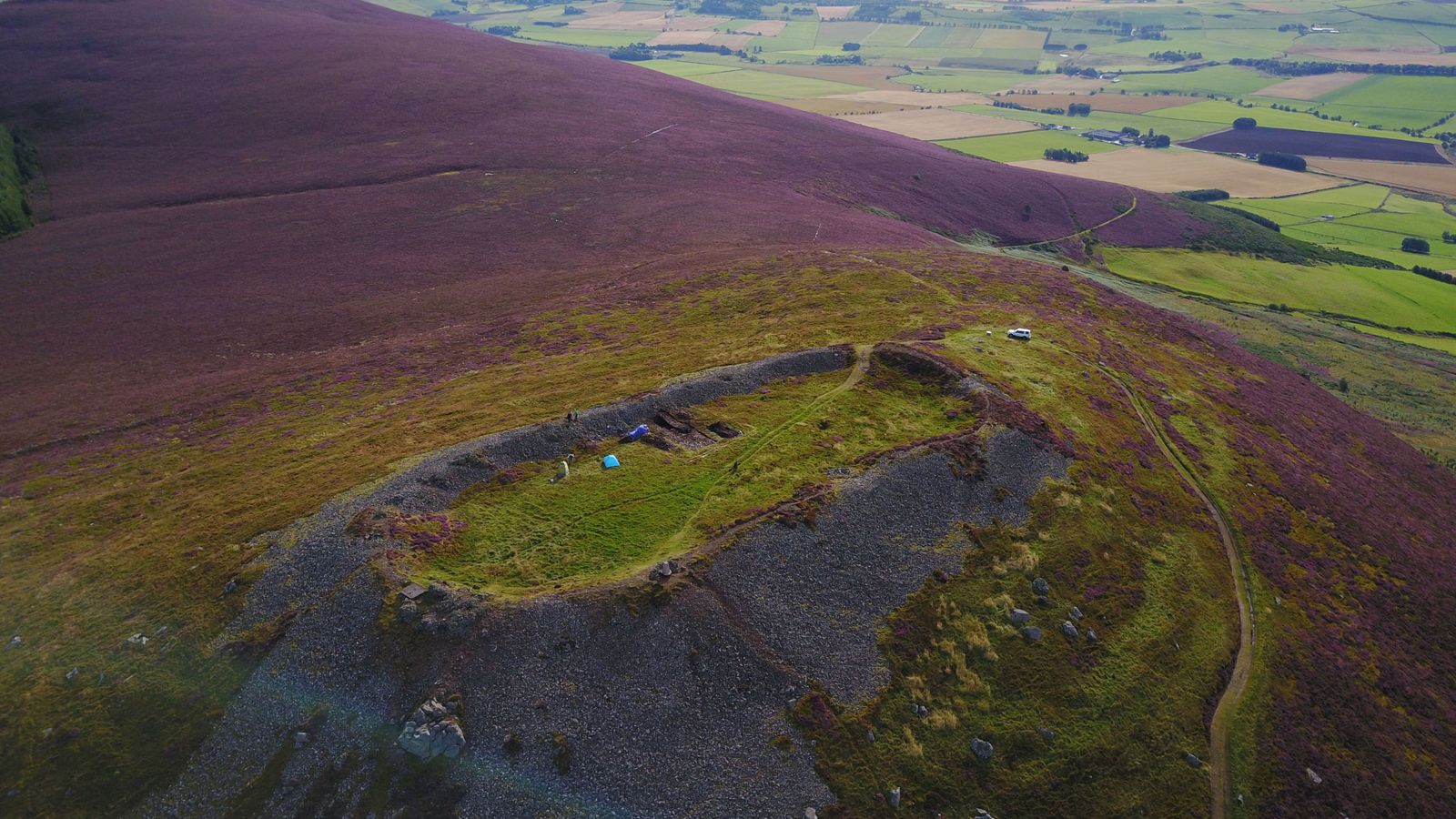
The site was analysed using radiocarbon dating
A hillfort overlooking a small village has been revealed as one of the largest ancient settlements ever discovered in Scotland.
Up to 4,000 people may have lived in more than 800 huts on the Tap O' Noth, close to the village of Rhynie in the fifth to sixth centuries.
The Aberdeenshire settlement may, in fact, date back as far as the third century, meaning it is likely to be Pictish in origin.
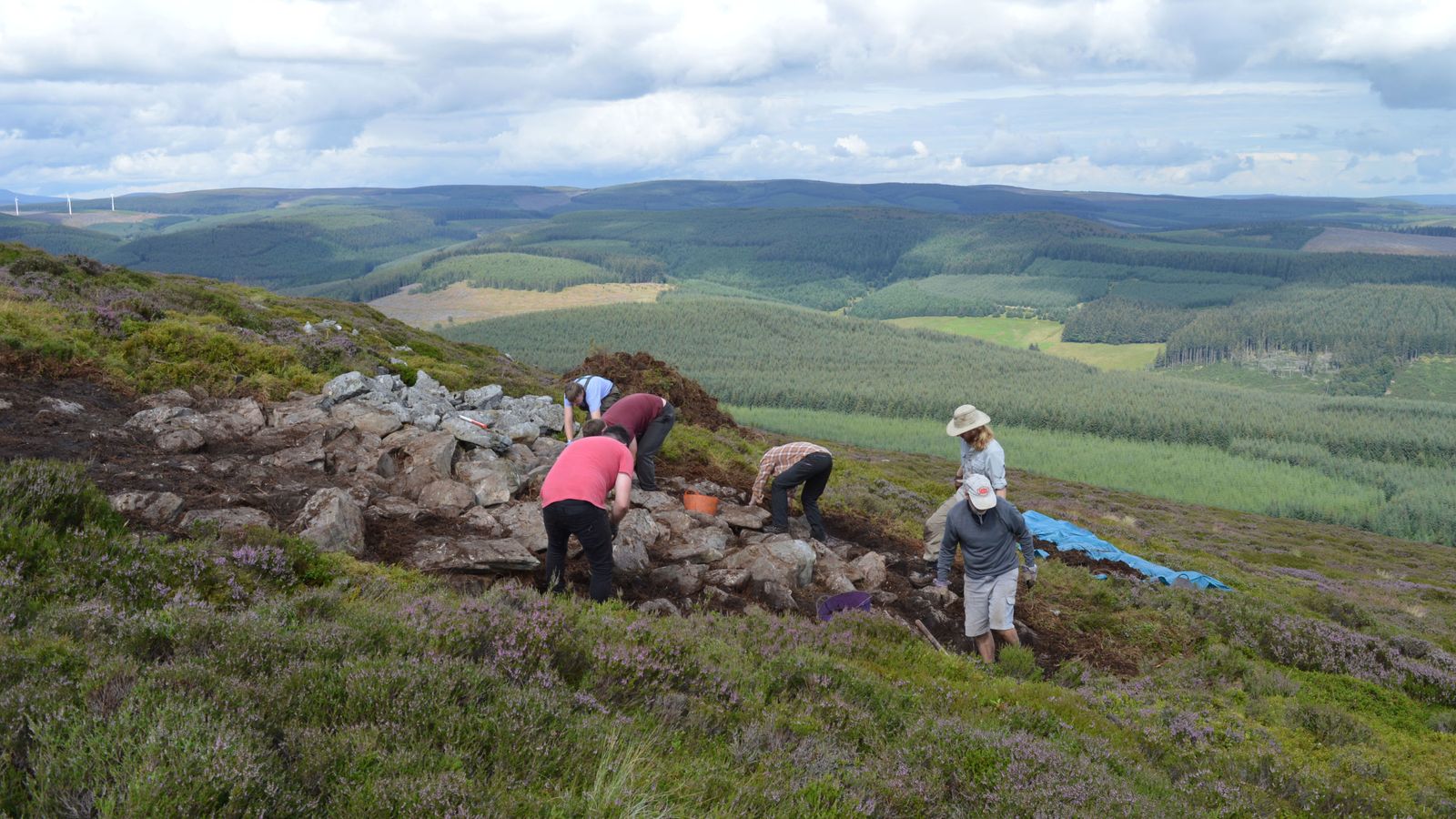
Archaeologists at work on the site
The Picts were a collection of Celtic-speaking communities who lived in the east and north of Scotland during the Late British Iron Age and Early Medieval periods.
More:
https://news.sky.com/story/scotland-mind-blowing-ancient-settlement-found-on-hilltop-11988414
~ ~ ~
Ancient Tap O' Noth hillfort in Aberdeenshire one of 'largest ever'
14 May 2020 NE Scotland, Orkney & Shetland
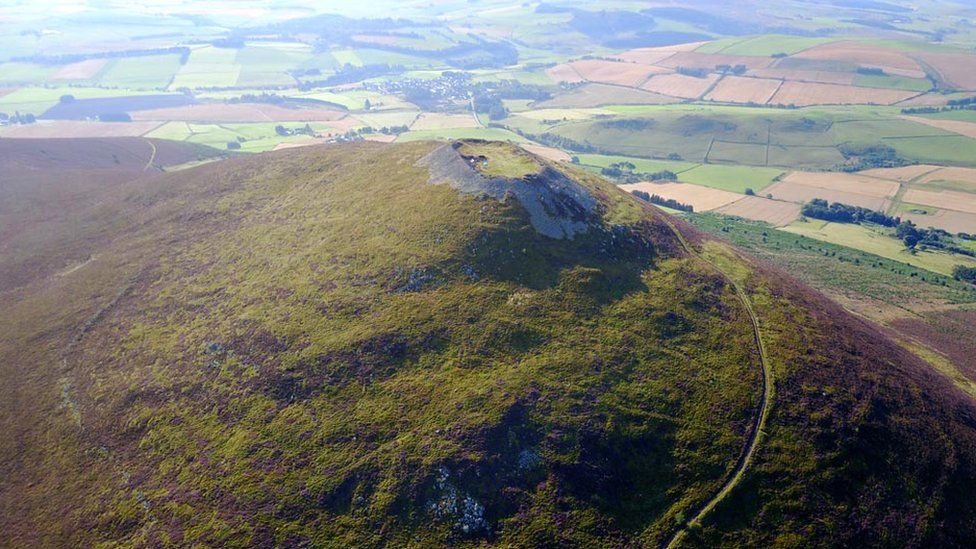
UNIVERSITY OF ABERDEENTap O' Noth
A hillfort in Aberdeenshire is one of the largest ancient settlements ever discovered in Scotland, researchers have said.
University of Aberdeen archaeologists say 4,000 people may have lived in more than 800 huts perched high on the Tap O' Noth near Rhynie.
Many had thought it dated from the Bronze or Iron Age.
The team said carbon dating suggested it was likely to be Pictish, dating back as far as the third century AD.
They believe at its height it may have rivalled the largest known post-Roman settlements in Europe.
More:
https://www.bbc.com/news/amp/uk-scotland-north-east-orkney-shetland-52660032
~ ~ ~
Steps to ancient hillfort well in Aberdeenshire uncovered
18 June 2019
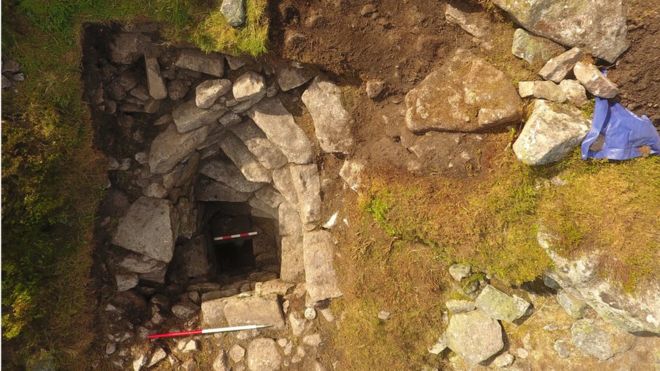
NORTHERN PICTS/UNIVERSITY OF ABERDEEN
Image caption
The steps and the well are being seen for the first time since the site was first recorded in the 1800s
Archaeologists have revealed the steps to an ancient hillfort's well in Aberdeenshire.
The site on Mither Tap, a summit on Bennachie, a hill near Inverurie, was first recorded in the 1800s before being covered over.
University of Aberdeen's Northern Picts project said its excavation meant the steps could been seen for the first time in more than 200 years.
Archaeologists believe the steps could be 1,000 years old,
The fort could date to the Iron Age or early medieval period.
~ ~ ~
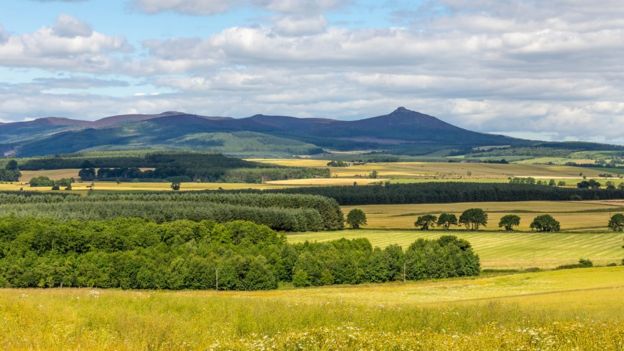
More:
https://www.bbc.com/news/uk-scotland-north-east-orkney-shetland-48675964
In the memory of horror and pain, Salvadorans overcome massacre with faith
In the memory of horror and pain, Salvadorans overcome massacre with faith
Rhina Guidos | Catholic News Service
May 13, 2020
. . .
The place where the Rivera family lived, the department of Chalatenango, is a rural region in the northernmost part of El Salvador, where government officials periodically carried out brutal attacks on the peasant population, killing, raping and pillaging the rural towns, justifying the actions by saying the residents were rebels or rebel sympathizers.
The Sumpul River massacre isn't the only massacre Rivera and others in the group survived, it was just the most brutal one.
Chalatenango is said to have been the setting of more than 50 such mass killings during the country's 12-year civil conflict, and almost all of the Sumpul survivors lost family members in other attacks. The Sumpul River massacre, however, is the most well-known in the department, though little is spoken about it at the national level because, even today, its remote setting, deep inside a mountainous area, makes it difficult for many to access the site where it happened and where annual commemorations take place.
Survivors say on May 13, 1980, the day before the massacre, hundreds of armed soldiers on the Salvadoran side of the river began invading towns around the Sumpul, driving terrified residents toward the river, toward a demilitarized zone known as Las Aradas, a hamlet on the riverbank where locals regularly had flocked to seek safety.
Soldiers on the Honduran side, in the meantime, began combing for Salvadorans who had been hiding in the brush near their side of the border, driving them, too, toward the Sumpul. At 7 a.m. the next day, when soldiers on both sides had trapped a large group of peasants in a perimeter, they opened fire on them. Some died by bullets, as the assault included an attack from two helicopters, with soldiers shooting from above and members of a paramilitary group on the ground. Some victims, including many children, drowned in the river because they couldn't swim and were carried away by the current.
When Rivera and his father managed to hide in thick brush, it proved to be a front seat to "barbarity," he said. He remembers watching soldiers order the men to line up, then opened fire on them. Children were taken from the arms of their mothers and some babies thrown in the air and caught on the way down on bayonets, he said.
More:
https://angelusnews.com/faith/in-the-memory-of-horror-and-pain-salvadorans-overcome-massacre-with-faith/
Historical Background
On May 14, 1980, hundreds of people from different communities gathered in Las Aradas, a small village in the district of Yurique, located on the banks of the Sumpul River, near the border with Honduras. Las Aradas is part of the municipality of San José Ojos de Agua in the Department (province) of Chalatenango, El Salvador. The people gathered there to seek protection from violence because they faced daily persecution by the Salvadoran military, the national guard, and a paramilitary organization called ORDEN (Nationalist Democratic Organization).
https://images.squarespace-cdn.com/content/v1/5bb4de4abfba3e37b51f3f25/1561119594109-SCU1ZXM62ZA7JAMYD0ZZ/ke17ZwdGBToddI8pDm48kDHPSfPanjkWqhH6pl6g5ph7gQa3H78H3Y0txjaiv_0fDoOvxcdMmMKkDsyUqMSsMWxHk725yiiHCCLfrh8O1z4YTzHvnKhyp6Da-NYroOW3ZGjoBKy3azqku80C789l0mwONMR1ELp49Lyc52iWr5dNb1QJw9casjKdtTg1_-y4jz4ptJBmI9gQmbjSQnNGng/IMG_0500+2.JPG
Felipe, then a 25-year-old campesino, met with the other campesinos and campesinas who had arrived at Las Aradas the same day. Ana, aged 12, was also there with her mother and her 15-year old sister. So was Yanet, a 19-year old woman accompanied by her father and her baby. They had all taken refuge in Las Aradas because it was a historically demilitarized space. On previous occasions, when they knew about a military or ORDEN operation in the area, they organized civilians to go across the Sumpul River and hide in the Honduran hills until the Salvadoran government troops left the region.
At approximately 7:30 in the morning on May 14th, the Salvadoran army initiated their military operation. They came from every direction. From his vantage point, Felipe saw a group of soldiers running and shooting through the hills. The noise of shots and grenade explosions was everywhere. Many families, along with their children, tried to escape. Some sought shelter behind stone fences to protect their children while others ran, terrified, to the Sumpul River. When Felipe reached the Sumpul, he could see that countless people had jumped in the river for fear of being captured, and many were drowning. The river was swollen because of heavy rains the night before, and the current dragged people away. Felipe also jumped in the river, but he was caught by a group of drowning women who latched onto him and made him sink beneath the water. With incomprehensible strength in the agony of death, Felipe dove to the bottom and was able to escape. He emerged to the surface coughing up the water he had swallowed, and he managed to make it across the river. When he could finally stand on his feet, with the water up to his chest, he saw the army on the shoreline gunning down the people who were still struggling in the river. He watched as people fell dead right in front of his eyes, and he felt thankful that God had allowed him to survive. Once on the shore, he climbed to the top of a ravine and watched as a group of soldiers killed the wounded people in the water and searched for others hiding in the bushes on the banks of the river. The gunfire frightened Felipe so much that he decided to walk further into Honduras.
More:
https://www.asociacionsumpul.org/historical-background
~ ~ ~

The Sumpul river. Scene of many massacres during the El Salvadorian civil war. They murdered the people upstream and the bodies floated down river.
Joleen Richwine
~ ~ ~
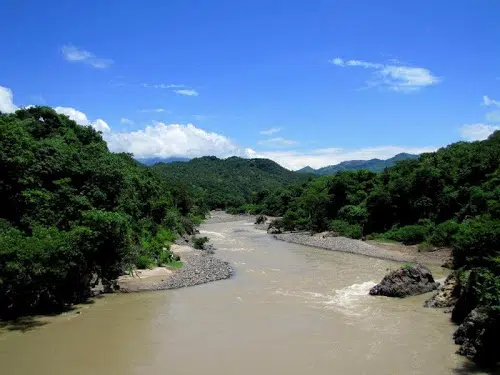
Historical Context
On May 14, 1980, the US-backed Salvadoran military massacred campesinos (peasants) in a tiny hamlet of Las Aradas, in the Department (Province) of Chalatenango. They had taken refuge there, knowing that the government army was initiating a counterinsurgency operation in the area. As the army descended on them, many lay by stone fences and were staffed by helicopters. Many others ran into the Sumpul River to try and make to Honduras (on the other side of the river), where they were shot at by soldiers. Many were gunned down and many others, especially children, drowned. At the end of the action, 600 people were dead. In August 2017, the survivor community formed the Association of Survivors of Chalatenango Massacres and one of their main goals is to build a memorial at the site of the Sumpul Massacre.
https://www.1069thex.com/2018/02/12/a-call-for-solidarity-survivors-of-the-1980-sumpul-river-massacre-in-el-salvador-inch-closer-to-justice/

~ ~ ~
Wikipedia:
. . .
Prelude
Following the 1969 Football War between El Salvador and Honduras, the Organization of American States (OAS) negotiated a ceasefire that established an OAS-monitored demilitarized zone (DMZ) three kilometers wide on each side of the border. When the Salvadoran Civil War began, many villages, including the hamlet Las Aradas, were abandoned and camps were formed within the DMZ on the Honduran side of the border to avoid harassment from the military, as well as the National Guard and paramilitary Organización Democrática Nacionalista (ORDEN), which did not cross the border.[2]
The Honduran government became concerned with Salvadoran refugees residing in Honduras, one of the causes of the Football War. The Salvadoran government believed these camps were being used by FMLN guerrillas, partly based on the membership of many peasants within the DMZ in the Federación de Trabajadores del Campo, a political organization promoting agrarian reform and seen by the Salvadoran government as supporting the guerillas.[2] In early 1980, FMLN guerrillas organized several small Salvadoran border villages and provided rudimentary military training. In early May, they began farming nearby fallow land.[3]
. . .
Massacre
On May 14, 1980, Salvadoran soldiers ordered the refugees to return from Sumpul River. They threatened to throw children into the river. The refugees did not return.[3] At 10:00 am, the soldiers fired "fistfuls" of bullets penetrating walls and killing many people and cattle.[4] They gathered and killed many refugees,[1] shooting them with machine guns,[1][4] bludgeoning them with rifle butts[4] or goring them with machetes and military knives.[1] ORDEN members threw babies and young children into the air and cleaved or decapitated them with machetes.[4]
The refugees attempted to cross the Sumpul river into Honduras,[1][4] but Honduran soldiers prevented them, possibly by shooting.[a] Salvadoran soldiers shot many refugees attempting to cross the river,[4][8] while many others, especially children, drowned.[8] Helicopters strafed the refugees hiding along stone fences.[8]
The massacre lasted six[4] to nine hours,[9] leaving at least 300 dead. Many sources place the death toll at 600.
More:
https://en.wikipedia.org/wiki/Sumpul_River_massacre
'Our Food System Is Very Much Modeled on Plantation Economics'
MAY 13, 2020
CounterSpin interview with Ricardo Salvador on the coronavirus food crisis
JANINE JACKSON

Janine Jackson interviewed the Union of Concerned Scientists’ Ricardo Salvador about the coronavirus food crisis for the May 8, 2020, episode of CounterSpin. This is a lightly edited transcript.
Janine Jackson: Listeners have likely seen the images: farmers dumping milk, smashing eggs, plowing produce under. At the same time, in the same country, people line up at food banks, unable to access or afford nutritious food.
At the nexus of the health crisis and the economic crisis of Covid-19 is a food crisis. And it’s along every dimension, from farm laborers to restaurant workers to hungry people. As with so many things, the pandemic didn’t create the problems, but it’s making them harder to deny.
. . .
JJ: If we could just talk, first, about the supply chain itself. What is it about the food system we have, that makes it a reasonable or necessary response to the crisis for some farmers to plow vegetables under that people could be eating?
RS: It has to do with the structure of agriculture, and I think your question is very well-framed. It actually is a logical thing for most farmers to plow under their food, rather than try to deal with a food system that is very specialized, that operates at very large scale. It’s very concentrated. And it operates along a few well-established channels. So it’s important to understand what those channels are, to then understand why it’s logical for farmers to do what is being reported, as well as to understand that this issue of food waste is a serious problem. And it is not exclusively on farmers. It’s an issue of the structure of the system.
More:
https://fair.org/home/our-food-system-is-very-much-modeled-on-plantation-economics/
How a trip to Honduras shaped one young US Afro Latino voter's identity
May 12, 2020 · 4:15 PM EDT
By Naomi Prioleau

Brayan Guevara, a 19-year-old college sophomore, at home in North Carolina.
Credit:
Naomi Prioleau/The World
This story is part of "Every 30 Seconds," a collaborative public media reporting project tracing the young Latino electorate leading up to the 2020 presidential election and beyond.
Freshman year of college was hard for Brayan Guevara. He almost failed his classes at Guilford Technical Community College in Greensboro, North Carolina.
Then his mother, a Spanish language professor at another nearby college, got an idea.
“She’s like, ‘Brayan, what’s going on?’ She knew something was wrong,” he said. “She was like, ‘Okay, I got something for you. This summer, you’re going away to Honduras.’”
Guevara, a 19-year-old with roots in Honduras, had never visited the country where so many of his relatives live. His mother, Nodia Mena, a Honduran immigrant, wanted Guevara to get away from the distractions of college life.
Guevara spent a month and a half last summer with his cousins in Trujillo, a city along Honduras’ northern Caribbean coast. What Guevara didn’t expect was how much the trip would shape his identity as an Afro Latino in the US. And that identity is shaping the issues most important to him as he considers how to cast his vote in the US presidential election this November. It will be his first time voting in a US election.
More:
https://www.pri.org/stories/2020-05-12/how-trip-honduras-shaped-one-young-us-afro-latino-voters-identity
This link is embedded in the story, but I'm posting it separately. So cool! I never heard of this, but it's amazing. The "punta" dance. Very, very likable instructor. She makes it look so easy.
Brazil arrests Argentine dictatorship fugitive on Rio coast
By ASSOCIATED PRESS
PUBLISHED: 12:19 EDT, 12 May 2020 | UPDATED: 12:24 EDT, 12 May 2020
RIO DE JANEIRO (AP) - Brazil's federal police agency says it has arrested a former Argentine navy officer accused of dictatorship-era crimes, including crimes against humanity and kidnapping.
The federal police didn´t release his identity, but a source with direct knowledge confirmed the man to be Gonzalo Sánchez, 69, also known as "Chispa."
He was caught Monday in the sleepy colonial city of Paraty, on Rio de Janeiro state's southern coast, and is suspected of forming part of a group that assassinated students, union members and opposition politicians, according to a federal police statement. Their bodies were thrown from planes on so-called "death flights."
Sánchez was previously arrested in 2013, and a judge ordered house arrest. In 2019, the Supreme Court authorized his extradition and he has since been in hiding.
He is suspected of participating in dozens of disappearances and killings, including that of journalist and writer Rodolfo Walsh in 1977. The school where Sánchez worked was one of the biggest illegal detention centers during the 1976-1983 military dictatorship. Sánchez has been on the run from Argentina´s justice system since 2005.
More:
https://www.dailymail.co.uk/wires/ap/article-8312421/Brazil-arrests-Argentine-dictatorship-fugitive-Rio-coast.html
~ ~ ~
Rodolfo Walsh's kidnapper captured in Brazil
Gonzalo 'Chispa' Sánchez, 69, was arrested on Monday by order of the Supreme Federal Court of Brazil. He is accused of more crimes against humanity.
MAY 12, 2020 - 4:12 PM
An Argentine repressor accused of crimes against humanity and having participated in the task forces of the Escuela Superior Mecánica de la Armada (ESMA), which kidnapped the writer and journalist Rodolfo Walsh in the civic-military dictatorship (1976-1983), was detained in Rio de Janeiro, Brazil , a diplomatic spokesman reported today.
This is Gonzálo Sánchez , known as "Chispa", who was arrested on Monday afternoon by the Brazilian Federal Police in the city of Paraty, in the southern region of the state of Rio de Janeiro, by an arrest warrant from the Supreme Court Federal of Brazil , to extradite him to Argentina.
Sánchez, 69, was detained by order of Judge Luiz Fux, of the Federal Supreme Court, who processes the extradition. The journalist Rodolfo Walsh was kidnapped and murdered after publishing his Open Letter in repudiation of the dictatorship, in 1977 .

Sánchez, detained in Brazil, is charged with the kidnapping of journalist Rodolfo Walsh and other crimes against humanity.
This will be the first extradition case on human rights issues from the government of President Jair Bolsonaro, who vindicates the Brazilian military dictatorship and recently praised former dictators Alfredo Stroessner, from Paraguay, and Augusto Pinochet, from Chile.
More:
https://www.dailymail.co.uk/wires/ap/article-8312421/Brazil-arrests-Argentine-dictatorship-fugitive-Rio-coast.html
Translated by Google:
05-12-2020 16:53
Gonzalo "Chispa" Sánchez, accused of the murder of Rodolfo Walsh, is captured in Brazil
The former prefect and repressor wanted for having participated in ESMA task forces, was arrested in Rio de Janeiro. This will be the first case of extradition on human rights issues from the government of President Jair Bolsonaro.

Gonzálo Sánchez
The former prefect and repressor Gonzalo "Chispa" Sánchez, accused of crimes against humanity and of having participated in the task forces of the Superior Mechanical School of the Navy ( ESMA ), who kidnapped the writer and journalist Rodolfo Walsh in the civic dictatorship military (1976-1983), was arrested in Rio de Janeiro. Sánchez, who was arrested on the afternoon of last Monday by the Brazilian Federal Police in the city of Paraty, in the south of the state of Rio de Janeiro, on an arrest warrant from the Supreme Federal Court of Brazil to extradite him to Argentina. Sánchez, 69, was detained by order of Judge Luiz Fux , of the Federal Supreme Court, who processes the extradition.
This will be the first case of extradition on human rights issues from the government of President Jair Bolsonaro , who vindicates the Brazilian military dictatorship and recently praised former dictators Alfredo Stroessner , from Paraguay, and Augusto Pinochet , from Chile.
In a statement, the Federal Police of Brazil reported that Sánchez was also participating in the so-called "death flights" to launch kidnapped detained disappeared into the Río de la Plata and the Atlantic Ocean.
"The request for preventive detention for extradition was made by the national representation of Interpol, based on information from the Red Alerts included there by the Argentine authorities , " the statement said.
"He was one of the guys who was the most in ´Capucha´, the ESMA sector where the hostages who had just arrived were housed. He was always with another well-known repressor, who was Antonio Pernías, whom they called ´Rat´" , told Carlos Loza , a survivor of the clandestine detention center and member of the Association of Former Detained and Disappeared (AEDD), which in several cases lawsuit against humanity.
"Chispa" was, according to survivors, one of the youngest repressors of ESMA, and of the fearsome Task Force 3.3.2 of the Navy.
Survivors' testimonies also placed him in General Pacheco's villa, which was a sort of annex to the clandestine center and where several detainees were housed.
The former prefect always wore plaid shirts, sports suits and always looked "very tanned, which made him more remarkable among the rest of the repressors."
"He liked to talk and brag about his actions. He told a group of kidnapped people what the elimination method that had been devised with the death flights was like. Before, he told us that the sailors burned the victims, and that he was a method that took a long time, " said journalist Myriam Lewin.
https://www.cronica.com.ar/info-general/Capturan-en-Brasil-a-Gonzalo-Chispa-Sanchez-acusado-por-el-asesinato-de-Rodolfo-Walsh-20200512-0053.html
BREAKING: State Legislators to Noem- State has no jurisdiction over the highways running through Ind
BREAKING: State Legislators to Noem- State has no jurisdiction over the highways running through Indian lands, cite 1990 ruling
Alaina Beautiful Bald Eagle | on May 10, 2020
Alaina Beautiful Bald Eagle
17 South Dakota Congressmen sent a bipartisan letter to Governor Kristi Noem stating that the State of South Dakota does not have the authority to enforce State law within the boundaries of a Reservation. The congressmen also criticized the governor’s actions as confrontational, demanding, and causing a constitutional crisis.
Furthermore, they criticized Governor Noem for failing to work with members of the legislature whose districts include tribal people, lands and government.
We could have helped facilitate conversations and given your office unique insight as to the history, culture, protocols, and vernacular of how to work together with Tribal governments. You elected, however, not to contact us and sent an ultimatum to both tribes,” the letter stated.
Among the legislators who signed the letter were Senators Troy Heinert and Red Dawn Foster, as well as Representatives Oren Lesmeister, Shawn Bordeaux, Peri Pourier and Tamara St. John all who have tribal jurisdictions within their districts.
The legislators stated that the State does not have authority to enforce State law within the boundaries of reservations, a point that the Cheyenne River Sioux Tribe has argued.
More:
https://www.westrivereagle.com/articles/breaking-state-legislators-to-noem-state-has-no-jurisdiction-over-the-highways-running-through-indian-lands-cite-1990-ruling/?fbclid=IwAR0npycrqR9sGCKz1ek8XJLlJz0yx1cJkY8dEsi7OC-w77A_q2R5ynjQN2g
'You can't recover from death': Argentina's Covid-19 response the opposite of Brazil's
Argentina closed swiftly, while Brazil downplayed the crisis. The difference is reflected in their pandemic figures
Uki Goñi in Buenos Aires and Tom Phillips in Rio de Janeiro
Sun 10 May 2020 05.00 EDTLast modified on Sun 10 May 2020 17.12 EDT
When Alberto Fernández took office as Argentina’s president in December, his inauguration was boycotted by Brazil’s hard-right leader, who dismissed Fernández and his vice-president, the two-time former president Cristina Fernández de Kirchner, as “leftwing bandits”.
For Jair Bolsonaro, Argentina’s new Peronist government represented a throwback to the “pink tide” of Latin American leaders which coincided with Fernández de Kirchner’s time in office from 2007 to 2015. “Argentina is starting to head in the direction of Venezuela,” Bolsonaro predicted.
Five months on, it is Brazil that is heading in the direction of a humanitarian emergency, amid a devastating coronavirus outbreak propelled by Bolsonaro’s dismissive attitude towards the pandemic.
The Brazilian president has downplayed the crisis as media “hysteria” and repeatedly rejected his own government’s social distancing recommendations, even as the death toll has soared.
In contrast, Argentina swiftly imposed a national lockdown, and appears to have successfully flattened the curve of contagion.
“You can recover from a drop in the GDP,” Fernández has said about his decision to implement an early lockdown. “But you can’t recover from death.”
More:
https://www.theguardian.com/world/2020/may/10/argentina-covid19-brazil-response-bolsonaro-fernandez
Six months after the coup, journalist Ollie Vargas says the 'Bolivian people have been abandoned'
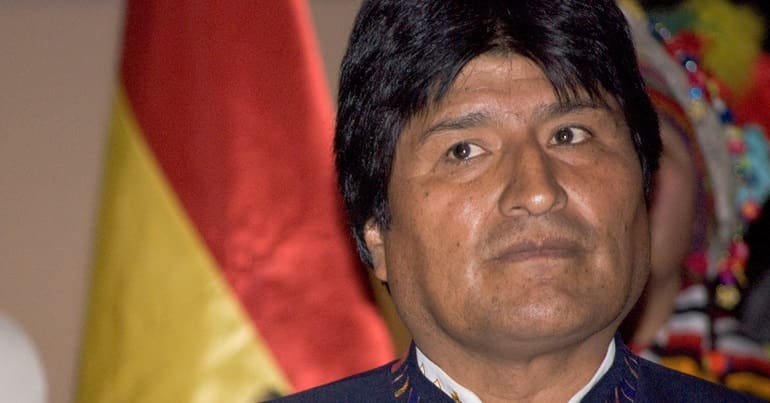
John McEvoy
10th May 2020
On 10 November 2019, sections of the Bolivian military and police launched a successful coup against socialist president Evo Morales. The coup was followed by a proliferation of violence steeped in Christian fundamentalism and Morales, Bolivia’s first Indigenous president, was forced to flee. New elections did not follow and the new administration, with the backing of the US government, looks unlikely to relinquish power any time soon.
The Canary spoke with journalist Ollie Vargas, who has been reporting from Bolivia since shortly after the coup. He recently launched Kawsachun News, an English-language news outlet which promises to be the authority on Bolivia.
We’re coming up to six months since the coup against Evo Morales in November 2019. Can you give a brief outline of how and why the coup in Bolivia occurred?
There were different stages to the coup. The Bolivian right realised that they were on course for their fourth electoral defeat and they became desperate.
The first phase was creating destabilisation through waves and waves of fake news. A large number of people were getting their news and information through WhatsApp groups and Facebook meme pages, which were pumping out vast amounts of fake news inciting people to take to the streets against a supposedly socialist dictator. That’s how the idea of electoral fraud was built up before any election even took place.
More:
https://www.thecanary.co/feature/2020/05/10/six-months-after-the-coup-journalist-ollie-vargas-says-the-bolivian-people-have-been-abandoned/
Profile Information
Member since: 2002Number of posts: 160,525


